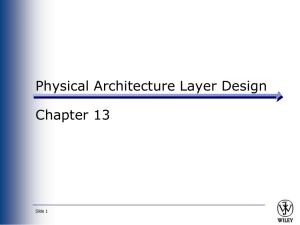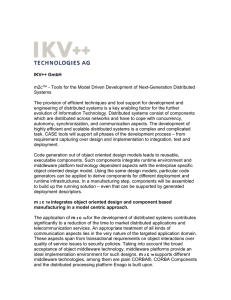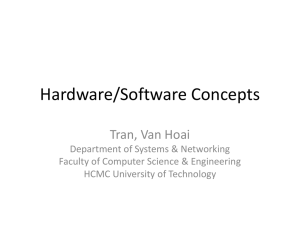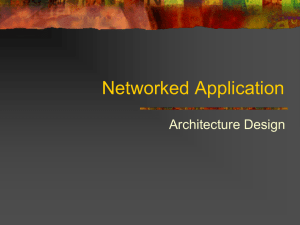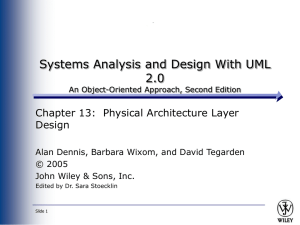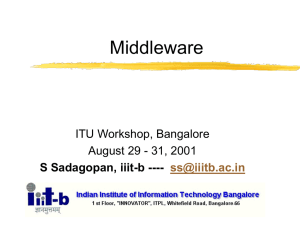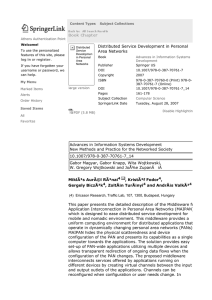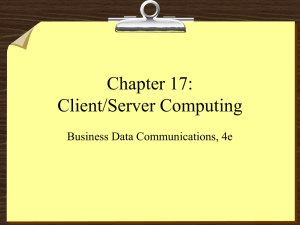Distributed Systems: Software Concepts & Operating Systems
advertisement
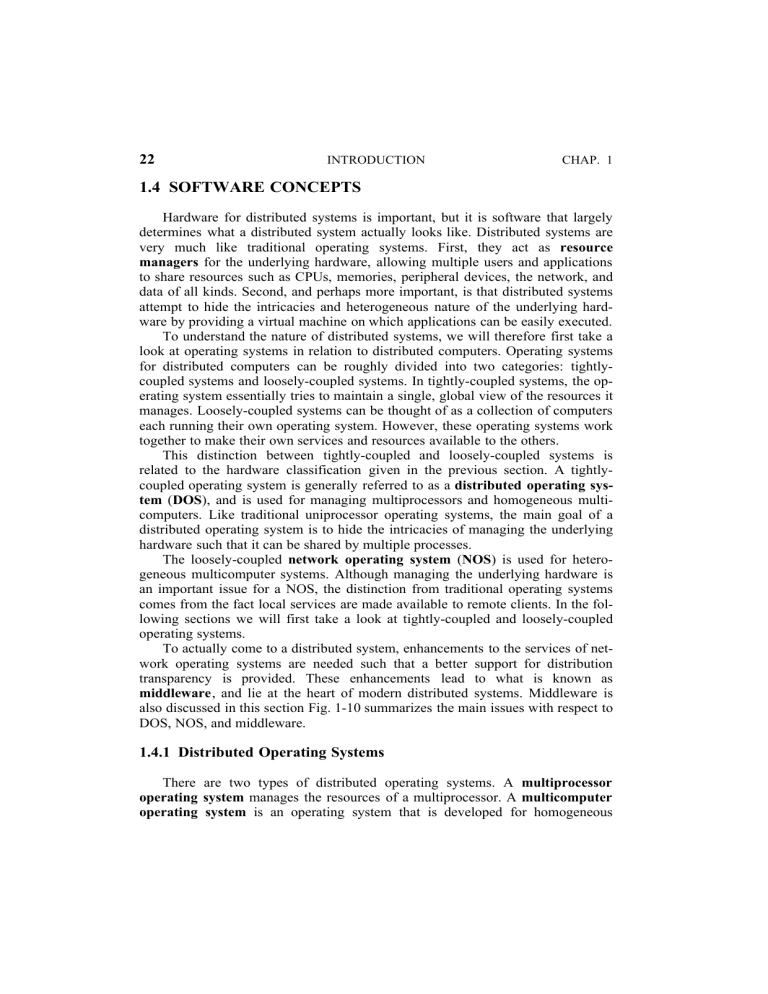
22
INTRODUCTION
CHAP. 1
1.4 SOFTWARE CONCEPTS
Hardware for distributed systems is important, but it is software that largely
determines what a distributed system actually looks like. Distributed systems are
very much like traditional operating systems. First, they act as resource
managers for the underlying hardware, allowing multiple users and applications
to share resources such as CPUs, memories, peripheral devices, the network, and
data of all kinds. Second, and perhaps more important, is that distributed systems
attempt to hide the intricacies and heterogeneous nature of the underlying hardware by providing a virtual machine on which applications can be easily executed.
To understand the nature of distributed systems, we will therefore first take a
look at operating systems in relation to distributed computers. Operating systems
for distributed computers can be roughly divided into two categories: tightlycoupled systems and loosely-coupled systems. In tightly-coupled systems, the operating system essentially tries to maintain a single, global view of the resources it
manages. Loosely-coupled systems can be thought of as a collection of computers
each running their own operating system. However, these operating systems work
together to make their own services and resources available to the others.
This distinction between tightly-coupled and loosely-coupled systems is
related to the hardware classification given in the previous section. A tightlycoupled operating system is generally referred to as a distributed operating system (DOS), and is used for managing multiprocessors and homogeneous multicomputers. Like traditional uniprocessor operating systems, the main goal of a
distributed operating system is to hide the intricacies of managing the underlying
hardware such that it can be shared by multiple processes.
The loosely-coupled network operating system (NOS) is used for heterogeneous multicomputer systems. Although managing the underlying hardware is
an important issue for a NOS, the distinction from traditional operating systems
comes from the fact local services are made available to remote clients. In the following sections we will first take a look at tightly-coupled and loosely-coupled
operating systems.
To actually come to a distributed system, enhancements to the services of network operating systems are needed such that a better support for distribution
transparency is provided. These enhancements lead to what is known as
middleware, and lie at the heart of modern distributed systems. Middleware is
also discussed in this section Fig. 1-10 summarizes the main issues with respect to
DOS, NOS, and middleware.
1.4.1 Distributed Operating Systems
There are two types of distributed operating systems. A multiprocessor
operating system manages the resources of a multiprocessor. A multicomputer
operating system is an operating system that is developed for homogeneous
SEC. 1.4
SOFTWARE CONCEPTS
23
222222222222222222222222222222222222222222222222222222222222222222222222222222
1 System
1
1
1
Description
Main goal
21 22222222222222222222222222222222222222222222222222222222222222222222222222222
1
1
1
1 DOS
1 Tightly-coupled operating system for multi1 Hide and manage 1
1 processors and homogeneous multicomputers 1 hardware resources 1
21 22222222222222222222222222222222222222222222222222222222222222222222222222222
1
1
1
1
1 NOS
1 Loosely-coupled operating system for hetero- 1 Offer local services 1
1 geneous multicomputers (LAN and WAN)
1 to remote clients
1
21 22222222222222222222222222222222222222222222222222222222222222222222222222222
1
1
1
1
1 Middleware 1 Additional layer atop of NOS implementing
1 Provide distribution 1
1222222222222222222222222222222222222222222222222222222222222222222222222222222
1 general-purpose services
1 transparency
1
Figure 1-10. An overview between DOS (Distributed Operating Systems),
NOS (Network Operating Systems), and middleware.
multicomputers. The functionality of distributed operating systems is essentially
the same as that of traditional operating systems for uniprocessor systems, except
that they handle multiple CPUs. Let us therefore briefly review uniprocessor
operating systems first. An introduction to operating systems for uniprocessors
and multiple processors can be found in (Tanenbaum, 2001).
Uniprocessor Operating Systems
Operating systems have traditionally been built to manage computers with
only a single CPU. The main goal of these systems is to allow users and applications an easy way of sharing resources such as the CPU, main memory, disks, and
peripheral devices. Sharing resources means that different applications can make
use of the same hardware in an isolated fashion. To an application, it appears as if
it has its own resources, and that there may be several applications executing on
the same system at the same time, each with their own set of resources. In this
sense, the operating system is said to implement a virtual machine, offering multitasking facilities to applications.
An important aspect of sharing resources in such a virtual machine, is that
applications are protected from each other. For example, it is not acceptable that if
two independent applications A and B are executed at the same time, that A can
alter the data of application B by simply accessing that part of main memory
where that data are currently stored. Likewise, we need to ensure that applications
can make use of facilities only as offered by the operating system. For instance, it
should generally be prevented that an application can directly copy messages to a
network interface. Instead, the operating system will provide communication
primitives, and only by means of these primitives should it be possible to send
messages between applications on different machines.
Consequently, the operating system should be in full control of how the
hardware resources are used and shared. Therefore, most CPUs support at least
two modes of operation. In kernel mode, all instructions are permitted to be executed, and the whole memory and collection of all registers is accessible during
24
INTRODUCTION
CHAP. 1
execution. In contrast, in user mode, memory and register access is restricted. For
example, an application will not be allowed to access memory locations that lie
outside a range of addresses (set by the operating system), or directly access
device registers. While executing operating system code, the CPU is switched to
kernel mode. However, the only way to switch from user mode to kernel mode is
through system calls as implemented by the operating system. Because system
calls are the only basic services an operating system offers, and because the
hardware helps to restrict memory and register access, an operating system can be
put into full control.
Having two modes of operation has led to organizations of operating systems
in which virtually all operating system code is executed in kernel mode. The
result is often a huge, monolithic program that is run in a single address space.
The drawback of this approach is that it is often difficult to adapt the system. In
other words, it is hard to replace or adapt operating system components without
doing a complete shutdown and possibly even a full recompilation and reinstallation. Monolithic operating systems are not a good idea from the perspective of openness, software engineering, reliability, or maintainability.
A more flexible approach is to organize the operating system into two parts.
The first part consists of a collection of modules for managing the hardware but
which can equally well be executed in user mode. For example, memory management basically consists of keeping track of which parts of memory have been allocated to processes, and which parts are free. The only time we need to execute in
kernel mode is when the registers of the MMU are set.
The second part of the operating system consists of a small microkernel containing only the code that must execute in kernel mode. In practice, a microkernel
need only contain the code for setting device registers, switching the CPU
between processes, manipulating the MMU, and capturing hardware interrupts. In
addition, it contains the code to pass system calls to calls on the appropriate userlevel operating system modules, and to return their results. This approach leads to
the organization shown in Fig. 1-11.
No direct data exchange between modules
OS interface
User
application
Memory
module
Process
module
File module
User mode
Kernel mode
System call
Microkernel
Hardware
Figure 1-11. Separating applications from operating system code through a microkernel.
SEC. 1.4
SOFTWARE CONCEPTS
25
Their are many benefits to using microkernels. An important one is its flexibility: because a large part of the operating system is executed in user mode, it is
relatively easy to replace a module without having to recompile or re-install the
entire system. Another important issue is that user-level modules can, in principle,
be placed on different machines. For example, we can easily place a file management module on a different machine than the one managing a directory service. In
other words, the microkernel approach lends itself well to extending a uniprocessor operating system to distributed computers.
Microkernels have two important disadvantages. First, they are different from
the way current operating systems work, and trying to change any well-entrenched
status quo always meets massive resistance (‘‘If this operating system is good
enough for my grandfather, it is good enough for me.’’). Second, microkernels
have extra communication and thus a slight performance loss. However, given
how fast modern CPUs are, a 20% performance loss is hardly fatal.
Multiprocessor Operating Systems
An important, but often not entirely obvious extension to uniprocessor operating systems, is support for multiple processors having access to a shared memory.
Conceptually, the extension is simple in that all data structures needed by the
operating system to manage the hardware, including the multiple CPUs, are
placed into shared memory. The main difference is that these data are now accessible by multiple processors, so that they have to be protected against concurrent
access to guarantee consistency.
However, many operating systems, especially those for PCs and workstations,
cannot easily handle multiple CPUs. The main reason is that they have been
designed as monolithic programs that can be executed only with a single thread of
control. Adapting such operating systems for multiprocessors generally means
redesigning and reimplementing the entire kernel. Modern operating systems are
designed from the start to be able to handle multiple processors.
Multiprocessor operating systems aim to support high performance through
multiple CPUs. An important goal is to make the number of CPUs transparent to
the application. Achieving such transparency is relatively easy because the communication between different (parts of) applications uses the same primitives as
those in multitasking uniprocessor operating systems. The idea is that all communication is done by manipulating data at shared memory locations, and that we
only have to protect that data against simultaneous access. Protection is done
through synchronization primitives. Two important (and equivalent) primitives are
semaphores and monitors.
A semaphore can be thought of as an integer with two operations, down and
up. The down operation checks to see if the value of the semaphore is greater
than 0. If so, it decrements its value and continues. If the value is 0, the calling
process is blocked. The up operation does the opposite. It first checks whether
26
INTRODUCTION
CHAP. 1
there are any now-blocked processes that were unable to complete an earlier down
operation. If so, it unblocks one of them and then continues. Otherwise, it simply
increments the semaphore value. An unblocked process can simply continue by
returning from the down operation. An important property of semaphore operations is that they are atomic, meaning that once a down or up operation has
started, no other process can access the semaphore until the operation is completed (or until a process blocks).
Programming with semaphores to synchronize processes is known to be
error-prone except when used for simply protecting shared data. The main problem is that the use of semaphores can easily lead to unstructured code, similar to
that resulting from abundantly using the infamous goto statement. As an alternative, many modern systems that support concurrent programming provide a library
for implementing monitors.
Formally, a monitor is a programming-language construct, similar to an object in object-based programming (Hoare, 1974) A monitor can be thought of as a
module consisting of variables and procedures. Variables can be accessed only by
calling one of the monitor’s procedures. In this sense, a monitor is similar to an
object: an object has its own private data, which can be accessed only by means of
methods implemented by that object. The difference with objects, is that a monitor will allow only a single process at a time to execute a procedure. In other
words, if a process A is executing a procedure contained in a monitor (we say that
A has entered the monitor), and a process B also calls one of the monitor’s procedures, B will be blocked until A completes (i.e., until A leaves the monitor).
As an example, consider a simple monitor for protecting an integer variable as
shown in Fig. 1-12. The monitor contains a single (private) variable count that
can be accessed only by means of three (public) procedures for respectively reading its current value, incrementing it by 1, or decrementing it. The monitor construct guarantees that any process that calls one of these procedures can atomically access the private data contained in the monitor.
monitor Counter {
private:
int count = 0;
public:
int value( ) { return count; }
void incr( ) { count = count + 1; }
void decr( ) { count = count − 1; }
}
Figure 1-12. A monitor to protect an integer against concurrent access.
So far, monitors are useful for simply protecting shared data. However, more
is needed for conditionally blocking a process. For example, suppose we wish to
SEC. 1.4
SOFTWARE CONCEPTS
27
block a process calling the operation decr when it finds out that the value of count
has dropped to 0. For such purposes, monitors also contain what is known as condition variables, which are special variables with two operations wait and signal.
When process A is inside a monitor, and calls wait on a condition variable contained in that monitor, A will block and give up its exclusive access to the monitor. Consequently, a process B that was waiting to enter the monitor can then continue. At a certain point, B may unblock process A by doing a signal on the condition variable that A is waiting on. To avoid having two processes active inside the
monitor, we adopt the scheme by which the signaling process must leave the monitor. We can now adapt our previous example. It can be verified that the monitor
shown in Fig. 1-13 is actually an implementation of a semaphore as discussed
above.
monitor Counter {
private:
int count = 0;
int blocked 3 procs = 0;
condition unblocked;
public:
int value( ) { return count; }
void incr( ) {
if (blocked 3 procs == 0)
count = count + 1;
else
signal( unblocked );
}
void decr( ) {
if (count == 0) {
blocked 3 procs = blocked 3 procs + 1;
wait( unblocked );
blocked 3 procs = blocked 3 procs − 1;
}
else
count = count − 1;
}
}
Figure 1-13. A monitor to protect an integer against concurrent access, but
blocking a process.
The drawback of monitors is that they are programming-language constructs.
For example, Java provides a notion of monitors by essentially allowing each
object to protect itself against concurrent access through synchronized statements,
28
INTRODUCTION
CHAP. 1
and operations wait and notify on objects. Library support for monitors is generally
given by means of simple semaphores that can only take on the values 0 and 1,
commonly referred as mutex variables, with associated lock and unlock operations. Locking a mutex will succeed only if the mutex is 1, otherwise the calling
process will be blocked. Likewise, unlocking a mutex means setting its value to 1,
unless some waiting process could be unblocked. Condition variables with their
associated operations are also provided as library routines. More information on
synchronization primitives can be found in (Andrews, 2000).
Multicomputer Operating Systems
Operating systems for multicomputers are of a totally different structure and
complexity than multiprocessor operating systems. This difference is caused by
the fact that data structures for systemwide resource management can no longer
be easily shared by merely placing them in physically shared memory. Instead,
the only means of communication is through message passing. Multicomputer
operating systems are therefore generally organized as shown in Fig. 1-14.
Machine A
Machine B
Machine C
Distributed applications
Distributed operating system services
Kernel
Kernel
Kernel
Network
Figure 1-14. General structure of a multicomputer operating system.
Each node has its own kernel containing modules for managing local
resources such as memory, the local CPU, a local disk, and so on. Also, each
node has a separate module for handling interprocessor communication, that is,
sending and receiving messages to and from other nodes.
Above each local kernel is a common layer of software that implements the
operating system as a virtual machine supporting parallel and concurrent execution of various tasks. In fact, as we shall discuss shortly, this layer may even provide an abstraction of a multiprocessor machine. In other words, it provides a
complete software implementation of shared memory. Additional facilities commonly implemented in this layer are, for example, those for assigning a task to a
processor, masking hardware failures, providing transparent storage, and general
SEC. 1.4
29
SOFTWARE CONCEPTS
interprocess communication. In other words, facilities that one would normally
expect from any operating system.
Multicomputer operating systems that do not provide a notion of shared
memory can offer only message-passing facilities to applications. Unfortunately,
the semantics of message-passing primitives may vary widely between different
systems. It is easiest to explain their differences by considering whether or not
messages are buffered. In addition, we need to take into account when, if ever, a
sending or receiving process is blocked. Fig. 1-15 shows where buffering and
blocking can take place.
Sender
Possible
synchronization
point
S1
Receiver
S4
Receiver
buffer
Sender
buffer
S2
S3
Network
Figure 1-15. Alternatives for blocking and buffering in message passing.
There are only two places where messages can possibly be buffered: at the
sender’s side or at the receiver’s side. This leads to four possible synchronization
points, that is, points at which a sender or receiver can possibly block. If there is a
buffer at the sender’s side, it makes sense to block the sender only when the
buffer is full, which is shown as synchronization point S1 in Fig. 1-15. Alternatively, putting a message into a buffer may return a status indicating whether the
operation succeeded. This avoids the sender being blocked when the buffer was
already full. Otherwise, when there is no sender buffer, there are three alternative
points to block the sender: the message has been sent (shown as S2), the message
has arrived at the receiver (synchronization point S3), or the message has been
delivered to the receiver (at point S4). Note that if blocking takes place at either
S2, S3, or S4, having a buffer at the sender’s side does not make any sense.
Blocking the receiver makes sense only at synchronization point S3, which
can happen only when there is no receiver buffer, or when the buffer is empty. An
alternative is to let the receiver poll for incoming messages. However, doing so
often results in a waste of CPU time, or responding too late to incoming messages,
which in turn may lead to buffer overflows resulting in incoming messages having
to be dropped (Bhoedjang et al., 1998).
Another issue that is important for understanding message-passing semantics,
is whether or not communication is reliable. The distinguishing feature of reliable
communication is that the sender is given a guarantee that its messages will be
30
INTRODUCTION
CHAP. 1
received. In Fig. 1-15, this means that all messages are guaranteed to make it to
synchronization point S3. With unreliable communication, no such guarantee is
given. When there is a buffer at the sender’s side communication can either be
reliable or not. Likewise, the operating system need not guarantee reliable communication when the sender is blocked at S2.
However, if the operating system blocks a sender until messages arrive at
either S3 or S4, it must guarantee reliable communication, or we may otherwise
find ourselves in a situation in which the sender is waiting for confirmation of
receipt or delivery, while in the meantime its message had been lost during
transmission. The relations between blocking, buffering, and guarantees regarding reliable communication are summarized in Fig. 1-16.
222222222222222222222222222222222222222222222222222222222222222222222222222222
1
1 Send buffer 1 Reliable comm. guaranteed? 1
Synchronization point
2
1 22222222222222222222222222222222222222222222222222222222222222222222222222222
1
1
1
Block sender until buffer not full
1
1222222222222222222222222222222222222222222222222222222222222222222222222222222
1 Yes
1 Not necessary
1
1 Block sender until message sent
1 No
1 Not necessary
2
1
1 22222222222222222222222222222222222222222222222222222222222222222222222222222
1
1
1
1222222222222222222222222222222222222222222222222222222222222222222222222222222
1 Necessary
Block sender until message received 1 No
1
1
1
1
Block
sender
until
message
delivered
No
Necessary
1222222222222222222222222222222222222222222222222222222222222222222222222222222
1
1
1
Figure 1-16. Relation between blocking, buffering, and reliable communication.
Many of the issues involved in building multicomputer operating systems are
equally important for any distributed system. The main difference between multicomputer operating systems and distributed systems is that the former generally
assume that the underlying hardware is homogeneous and is to be fully managed.
Many distributed systems, however, are often built on top of existing operating
systems, as we will discuss shortly.
Distributed Shared Memory Systems
Practice shows that programming multicomputers is much harder than programming multiprocessors. The difference is caused by the fact that expressing
communication in terms of processes accessing shared data and using simple synchronization primitives like semaphores and monitors is much easier than having
only message-passing facilities available. Issues like buffering, blocking, and reliable communication only make things worse.
For this reason, there has been considerable research in emulating sharedmemory on multicomputers. The goal is to provide a virtual shared memory
machine, running on a multicomputer, for which applications can be written using
the shared memory model even though this is not present. The multicomputer
operating system plays a crucial role here.
One approach is to use the virtual memory capabilities of each individual
node to support a large virtual address space. This leads to what is called a page-
SEC. 1.4
31
SOFTWARE CONCEPTS
based distributed shared memory (DSM). The principle of page-based distributed shared memory is as follows. In a DSM system, the address space is divided
up into pages (typically 4 KB or 8 KB), with the pages being spread over all the
processors in the system. When a processor references an address that is not
present locally, a trap occurs, and the operating system fetches the page containing the address and restarts the faulting instruction, which now completes successfully. This concept is illustrated in Fig. 1-17(a) for an address space with 16 pages
and four processors. It is essentially normal paging, except that remote RAM is
being used as the backing store instead of the local disk.
Shared global address space
0
0
1 2 3 4 5 6 7 8 9 10 11 12 13 14 15
2
5
9
1
3
6
4
8 10
CPU 1
7
11
13 15
12 14
Memory
CPU 3
CPU 2
CPU 4
(a)
0
2
5
9 10
1
3
6
4
8
CPU 1
7
11
13 15
12 14
CPU 3
CPU 2
CPU 4
(b)
0
2
9 10
CPU 1
5
1
3
6
4
8 10
7
11
13 15
12 14
CPU 2
CPU 3
CPU 4
(c)
Figure 1-17. (a) Pages of address space distributed among four machines. (b)
Situation after CPU 1 references page 10. (c) Situation if page 10 is read only
and replication is used.
In this example, if processor 1 references instructions or data in pages 0, 2, 5,
or 9, the references are done locally. References to other pages cause traps. For
32
INTRODUCTION
CHAP. 1
example, a reference to an address in page 10 will cause a trap to the operating
system, which then moves page 10 from machine 2 to machine 1, as shown in
Fig. 1-17(b).
One improvement to the basic system that can frequently improve performance considerably is to replicate pages that are read only, for example, pages
that contain program text, read-only constants, or other read-only data structures.
For example, if page 10 in Fig. 1-17 is a section of program text, its use by processor 1 can result in a copy being sent to processor 1, without the original in processor 2’s memory being disturbed, as shown in Fig. 1-17(c). In this way, processors 1 and 2 can both reference page 10 as often as needed without causing traps
to fetch missing memory.
Another possibility is to replicate not only read-only pages, but all pages. As
long as reads are being done, there is effectively no difference between replicating
a read-only page and replicating a read-write page. However, if a replicated page
is suddenly modified, special action has to be taken to prevent having multiple,
inconsistent copies in existence. Typically all copies but one are invalidated
before allowing the write to proceed.
Further performance improvements can be made if we let go of strict consistency between replicated pages. In other words, we allow a copy to be temporarily different from the others. Practice has shown that this approach may
indeed help, but unfortunately, can also make life much harder for the programmer as he has to be aware of such inconsistencies. Considering that ease of programming was an important reason for developing DSM systems in the first place,
weakening consistency may not be a real alternative. We return to consistency
issues in Chap. 6.
Another issue in designing efficient DSM systems, is deciding how large
pages should be. Here, we are faced with similar trade-offs as in deciding on the
size of pages in uniprocessor virtual memory systems. For example, the cost of
transferring a page across a network is primarily determined by the cost of setting
up the transfer and not by the amount of data that is transferred. Consequently,
having large pages may possibly reduce the total number of transfers when large
portions of contiguous data need to be accessed. On the other hand, if a page contains data of two independent processes on different processors, the operating system may need to repeatedly transfer the page between those two processors, as
shown in Fig. 1-18. Having data belonging to two independent processes in the
same page is called false sharing.
After almost 15 years of research on distributed shared memory, DSM
researchers are still struggling to combine efficiency and programmability. To
attain high performance on large-scale multicomputers, programmers resort to
message passing despite its higher complexity compared to programming (virtual)
shared memory systems. It seems therefore justified to conclude that DSM for
high-performance parallel programming cannot fulfill its initial expectations.
More information on DSM can be found in (Protic et al., 1998).
SEC. 1.4
33
SOFTWARE CONCEPTS
Machine A
Machine B
Page transfer when
B needs to be accessed
A
A
B
B
Page transfer when
A needs to be accessed
Page p
Code using A
Two independent
data items
Page p
Code using B
Figure 1-18. False sharing of a page between two independent processes.
1.4.2 Network Operating Systems
In contrast to distributed operating systems, network operating systems do not
assume that the underlying hardware is homogeneous and that it should be
managed as if it were a single system. Instead, they are generally constructed
from a collection of uniprocessor systems, each with its own operating system, as
shown in Fig. 1-19. The machines and their operating systems may be different,
but they are all connected to each other in a computer network. Also, network
operating systems provide facilities to allow users to make use of the services
available on a specific machine. It is perhaps easiest to describe network operating systems by taking a closer look at some services they typically offer.
Machine A
Machine B
Machine C
Distributed applications
Network OS
services
Kernel
Network OS
services
Kernel
Network OS
services
Kernel
Network
Figure 1-19. General structure of a network operating system.
A service that is commonly provided by network operating systems is to allow
a user to log into another machine remotely by using a command such as
rlogin machine
The effect of this command is to turn the user’s own workstation into a remote
terminal logged into the remote machine. Assuming the user is sitting behind a
34
INTRODUCTION
CHAP. 1
graphical workstation, commands typed on the keyboard are sent to the remote
machine, and output from the remote machine is displayed in a window on the
user’s screen. To switch to a different remote machine, it is necessary to first open
a new window, and then to use the rlogin command to connect to another
machine. The selection of the machine is thus entirely manual.
Network operating systems often also have a remote copy command to copy
files from one machine to another. For example, a command such as
rcp machine1:file1 machine2:file2
might copy the file file1 from machine1 to machine2 and give it the name file2
there. Again here, the movement of files is explicit and requires the user to be
completely aware of where all files are located and where all commands are being
executed.
While better than nothing, this form of communication is extremely primitive
and has led system designers to search for more convenient forms of communication and information sharing. One approach is to provide a shared, global file system accessible from all the workstations. The file system is supported by one or
more machines called file servers. The file servers accept requests from user programs running on the other (nonserver) machines, called clients, to read and write
files. Each incoming request is examined and executed, and the reply is sent back,
as illustrated in Fig. 1-20.
File server
Client 1
Disks on which
shared file system
is stored
Client 2
Request
Reply
Network
Figure 1-20. Two clients and a server in a network operating system.
File servers generally maintain hierarchical file systems, each with a root
directory containing subdirectories and files. Workstations can import or mount
these file systems, augmenting their local file systems with those located on the
servers. For example, in Fig. 1-21, two file servers are shown. One has a directory
called games, while the other has a directory called work (directory names are
shown in boldface). These directories each contain several files. Both of the
clients shown have mounted both of the servers, but they have mounted them in
different places in their respective file systems. Client 1 has mounted them in its
root directory, and can access them as /games and /work, respectively. Client 2,
like client 1, has mounted work in its root directory, but considers playing games
SEC. 1.4
35
SOFTWARE CONCEPTS
as something that should perhaps be kept private. It therefore created a directory
called /private and mounted games there. Consequently, it can access pacwoman
using the path /private/games/pacwoman rather than /games/pacwoman.
Client 1
/
Client 2
Server 1
games
/
Server 2
work
pacman
pacwoman
pacchild
private
mail
teaching
research
(a)
Client 1
Client 2
/
/
games
work
pacman
pacwoman
pacchild
private/games
work
mail
teaching
research
(b)
mail
teaching
research
pacman
pacwoman
pacchild
(c)
Figure 1-21. Different clients may mount the servers in different places.
While it often does not matter where a client mounts a server in its directory
hierarchy, it is important to notice that different clients can have a different view
of the file system. The name of a file depends on where it is being accessed from,
and how that machine has set up its file system. Because each client machine
operates relatively independently of the others, there is no guarantee that they all
present the same directory hierarchy to their programs.
Network operating systems are clearly more primitive than distributed operating systems. The main distinction between the two types of operating systems is
that distributed operating systems make a serious attempt to realize full transparency, that is, provide a single-system view.
The lack of transparency in network operating systems has some obvious
drawbacks. For example, they are often harder to use, as users are required to
explicitly log into remote machines, or copy files from one machine to another.
There is also a management problem. Because all machines in a network operating system are independent, often they can only be managed independently. As a
consequence, a user can do a remote login to a machine X only if he has an
account on X. Likewise, if a user wants to use only a single password, changing a
password requires changing it explicitly on every machine. In the same line of
reasoning, it is seen that, in general, all access permissions have to be maintained
per machine as well. There is no simple way of changing permissions once they
36
INTRODUCTION
CHAP. 1
are the same everywhere. This decentralized approach to security sometimes
makes it hard to protect network operating systems against malicious attacks.
There are also some advantages compared to distributed operating systems.
As the nodes in a network operating system are highly independent of each other,
it is easy to add or remove a machine. In some cases, the only thing we need to do
to add a machine is to connect the machine to a common network and, subsequently, make its existence known to the other machines in that network. In the
Internet, for example, adding a new server is done precisely in this way. To make
a machine known across the Internet, we need merely provide its network address,
or better, give the machine a symbolic name that we subsequently enter into DNS,
along with its network address.
1.4.3 Middleware
Neither a distributed operating system or a network operating system really
qualifies as a distributed system according to our definition given in Sec. 1.1. A
distributed operating system is not intended to handle a collection of independent
computers, while a network operating system does not provide a view of a single
coherent system. The question comes to mind whether it is possible to develop a
distributed system that has the best of both worlds: the scalability and openness of
network operating systems and the transparency and related ease of use of distributed operating systems. The solution is to be found in an additional layer of software that is used in network operating systems to more or less hide the heterogeneity of the collection of underlying platforms but also to improve distribution
transparency. Many modern distributed systems are constructed by means of such
an additional layer of what is called middleware. In this section we take a closer
look at what middleware actually constitutes by explaining some of its features.
Positioning Middleware
Many distributed applications make direct use of the programming interface
offered by network operating systems. For example, communication is often
expressed through operations on sockets, which allow processes on different
machines to pass each other messages (Stevens, 1998). In addition, applications
often make use of interfaces to the local file system. As we explained, a problem
with this approach is that distribution is hardly transparent. A solution is to place
an additional layer of software between applications and the network operating
system, offering a higher level of abstraction. Such a layer is accordingly called
middleware. It sits in the middle between applications and the network operating
system as shown in Fig. 1-22.
Each local system forming part of the underlying network operating system is
assumed to provide local resource management in addition to simple communication means to connect to other computers. In other words, middleware itself will
not manage an individual node; this is left entirely to the local operating system.
SEC. 1.4
37
SOFTWARE CONCEPTS
Machine A
Machine B
Machine C
Distributed applications
Middleware services
Network OS
services
Kernel
Network OS
services
Kernel
Network OS
services
Kernel
Network
Figure 1-22. General structure of a distributed system as middleware.
An important goal is to hide heterogeneity of the underlying platforms from
applications. Therefore, many middleware systems offer a more-or-less complete
collection of services and discourage using anything else but their interfaces to
those services. In other words, skipping the middleware layer and immediately
calling services of one of the underlying operating systems is often frowned upon.
We will return to middleware services shortly.
It is interesting to note that middleware was not invented as an academic exercise in achieving distribution transparency. After the introduction and widespread
use of network operating systems, many organizations found themselves having
lots of networked applications that could not be easily integrated into a single system (Bernstein, 1996). At that point, manufacturers started to build higher-level,
application-independent services into their systems. Typical examples include
support for distributed transactions and advanced communication facilities.
Of course, agreeing on what the right middleware should be is not easy. An
approach is to set up an organization which subsequently defines a common standard for some middleware solution. At present, there are a number of such standards available. The standards are generally not compatible with each other, and
even worse, products implementing the same standard but from different
manufacturers rarely interwork. Surely, it will not be long before someone offers
‘‘upperware’’ to remedy this defect.
Middleware Models
To make development and integration of distributed applications as simple as
possible, most middleware is based on some model, or paradigm, for describing
distribution and communication. A relatively simple model is that of treating
everything as a file. This is the approach originally introduced in UNIX and
38
INTRODUCTION
CHAP. 1
rigorously followed in Plan 9 (Pike et al., 1995). In Plan 9, all resources, including I/O devices such as keyboard, mouse, disk, network interface, and so on, are
treated as files. Essentially, whether a file is local or remote makes no difference.
An application opens a file, reads and writes bytes, and closes it again. Because
files can be shared by several processes, communication reduces to simply accessing the same file.
A similar approach, but less strict than in Plan 9, is followed by middleware
centered around distributed file systems. In many cases, such middleware is
actually only one step beyond a network operating system in the sense that distribution transparency is supported only for traditional files (i.e., files that are used
for merely storing data). For example, processes are often required to be started
explicitly on specific machines. Middleware based on distributed file systems has
proven to be reasonable scalable, which contributes to its popularity.
Another important early middleware model is that based on Remote Procedure Calls (RPCs). In this model, the emphasis is on hiding network communication by allowing a process to call a procedure of which an implementation is
located on a remote machine. When calling such a procedure, parameters are transparently shipped to the remote machine where the procedure is subsequently executed, after which the results are sent back to the caller. It therefore appears as if
the procedure call was executed locally: the calling process remains unaware of
the fact that network communication took place, except perhaps for some loss of
performance. We return to remote procedure calls in the next chapter.
As object orientation came into vogue, it became apparent that if procedure
calls could cross machine boundaries, it should also be possible to invoke objects
residing on remote machines in a transparent fashion. This has now led to various
middleware systems offering a notion of distributed objects. The essence of distributed objects is that each object implements an interface that hides all the internal details of the object from its users. An interface consists of the methods that
the object implements, no more and no less. The only thing that a process sees of
an object is its interface.
Distributed objects are often implemented by having each object itself located
on a single machine, and additionally making its interface available on many other
machines. When a process invokes a method, the interface implementation on the
process’s machine simply transforms the method invocation into a message that is
sent to the object. The object executes the requested method and sends back the
result. The interface implementation subsequently transforms the reply message
into a return value, which is then handed over to the invoking process. As in the
case of RPC, the process may be kept completely unaware of the network communication.
What models can do to simplify the use of networked systems is probably best
illustrated by the World Wide Web. The success of the Web is mainly due to the
extremely simple, yet highly effective model of distributed documents. In the
model of the Web, information is organized into documents, with each document
SEC. 1.4
SOFTWARE CONCEPTS
39
residing at a machine transparently located somewhere in the world. Documents
contain links that refer to other documents. By following a link, the document to
which that link refers is fetched from its location and displayed on the user’s
screen. The concept of a document need not be restricted to only text-based information. For example, the Web also supports audio and video documents, as well
as all kinds of interactive graphic-based documents.
We return to middleware paradigms extensively in the second part of the
book.
Middleware Services
There are a number of services common to many middleware systems. Invariably, all middleware, one way or another, attempts to implement access transparency, by offering high-level communication facilities that hide the low-level
message passing through computer networks. The programming interface to the
transport layer as offered by network operating systems is thus entirely replaced
by other facilities. How communication is supported depends very much on the
model of distribution the middleware offers to users and applications. We already
mentioned remote procedure calls and distributed-object invocations. In addition,
many middleware systems provide facilities for transparent access to remote data,
such as distributed file systems or distributed databases. Transparently fetching
documents as is done in the Web is another example of high-level (one-way) communication.
An important service common to all middleware is that of naming. Name
services allow entities to be shared and looked up (as in directories), and are comparable to telephone books and the yellow pages. Although naming may seem
simple at first thought, difficulties arise when scalability is taken into account.
Problems are caused by the fact that to efficiently look up a name in a large-scale
system, the location of the entity that is named must be assumed to be fixed. This
assumption is made in the World Wide Web, in which each document is currently
named by means of a URL. A URL contains the name of the server where the
document to which the URL refers is stored. Therefore, if the document is moved
to another server, its URL ceases to work.
Many middleware systems offer special facilities for storage, also referred to
as persistence. In its simplest form, persistence is offered through a distributed
file system, but more advanced middleware have integrated databases into their
systems, or otherwise provide facilities for applications to connect to databases.
In environments where data storage plays an important role, facilities are generally offered for distributed transactions. An important property of a transaction is that it allows multiple read and write operations to occur atomically. Atomicity means that the transaction either succeeds, so that all its write operations are
actually performed, or it fails, leaving all referenced data unaffected. Distributed
transactions operate on data that are possibly spread across multiple machines.
40
INTRODUCTION
CHAP. 1
Especially in the face of masking failures, which is often hard in distributed systems, it is important to offer services such as distributed transactions. Unfortunately, transactions are hard to scale across many local machines, let alone geographically dispersed machines.
Finally, virtually all middleware systems that are used in nonexperimental
environments provide facilities for security. Compared to network operating systems, the problem with security in middleware is that it should be pervasive. In
principle, the middleware layer cannot rely on the underlying local operating systems to adequately support security for the complete network. Consequently,
security has to be partly implemented anew in the middleware layer itself. Combined with the need for extensibility, security has turned out to be one of the hardest services to implement in distributed systems.
Middleware and Openness
Modern distributed systems are generally constructed as middleware for a
range of operating systems. In this way, applications built for a specific distributed system become operating system independent. Unfortunately, this independence is often replaced by a strong dependency on specific middleware. Problems
are caused by the fact that middleware is often less open than claimed.
As we explained previously, a truly open distributed system is specified by
means of interfaces that are complete. Complete means that everything that is
needed for implementing the system, has indeed been specified. Incompleteness
of interface definitions leads to the situation in which system developers may be
forced to add their own interfaces. Consequently, we may end up in a situation in
which two middleware systems from different development teams adhere to the
same standard, but applications written for one system cannot be easily ported to
the other.
Equally bad is the situation in which incompleteness leads to a situation in
which two different implementations can never interoperate, despite the fact that
they implement exactly the same set of interfaces but different underlying protocols. For example, if two different implementations rely on incompatible communication protocols as available in the underlying network operating system,
there is little hope that interoperability can be easily achieved. What we need is
that middleware protocols and the interfaces to the middleware are the same, as
shown in Fig. 1-23.
As another example, to ensure interoperability between different implementations, it is necessary that entities within the different systems are referenced in the
same way. If entities in one system are referred by means of URLs, while the
other system implements references using network addresses, it is clear that cross
referencing is going to be a problem. In such cases, the interface definitions
should have prescribed precisely what references look like.
SEC. 1.4
SOFTWARE CONCEPTS
Application
Middleware
Network OS
Same
programming
interface
Common
protocol
41
Application
Middleware
Network OS
Figure 1-23. In an open middleware-based distributed system, the protocols
used by each middleware layer should be the same, as well as the interfaces they
offer to applications.
A Comparison between Systems
A brief comparison between distributed operating systems, network operating
systems, and (middleware-based) distributed systems is given in Fig. 1-24.
2222222222222222222222222222222222222222222222222222222222222222222222222222222
1
1 Network OS 1 Middleware- 1
Item
Distributed OS
1
12222222222222222222222222221
1
1
12222222222222222222222222222222222222222222222222222222222222222222222222222222
1 Multiproc. 1 Multicomp. 1
1 based DS 1
1
1 Degree of transparency 1 Very high
1 Low
1 High
1
1 High
12222222222222222222222222222222222222222222222222222222222222222222222222222222
1
1
1
1
1 Yes
12222222222222222222222222222222222222222222222222222222222222222222222222222222
1 No
1 No
1
Same OS on all nodes? 1 Yes
1
1
1
1
1
1
1
Number
of
copies
of
OS
1
N
N
N
12222222222222222222222222222222222222222222222222222222222222222222222222222222
1
1
1
1
1
1 Basis for communication 1 Shared
1 Files
1 Model
1
Messages
1
1
1 memory
1
1 specific
1
1
12222222222222222222222222222222222222222222222222222222222222222222222222222222
1
1
1
1
1
1 Resource management 1 Global,
1 Per node
1 Per node
1
Global,
1
1
1 central
1
1
1
distributed
1
2
1 222222222222222222222222222222222222222222222222222222222222222222222222222222
1
1
1
1
1 Moderately 1 Yes
Scalability
12222222222222222222222222222222222222222222222222222222222222222222222222222222
1 No
1 Varies
1
1
1 Openness
1 Closed
1 Open
1 Open
1
Closed
1
12222222222222222222222222222222222222222222222222222222222222222222222222222222
1
1
1
1
1
1
Figure 1-24. A comparison between multiprocessor operating systems, multicomputer operating systems, network operating systems, and middleware-based
distributed systems.
With respect to transparency, it is clear that distributed operating systems do a
better job than network operating systems. In multiprocessor systems we have to
hide only that there are more processors, which is relatively easy. The hard part is
also hiding that memory is physically distributed, which is why building multicomputer operating systems that support full distribution transparency is so difficult. Distributed systems often improve transparency by adopting a specific model
for distribution and communication. For example, distributed file systems are generally good at hiding the location and access to files. However, they lose some
generality as users are forced to express everything in terms of that specific
model, which may be sometimes inconvenient for a specific application.
42
INTRODUCTION
CHAP. 1
Distributed operating systems are homogeneous, implying that each node runs
the same operating system (kernel). In multiprocessor systems, no copies of tables
and such are needed, as they can all be shared through main memory. In this case,
all communication also happens through main memory, whereas in multicomputer
operating systems messages are used. In network operating systems, one could
argue that communication is almost entirely file based. For example, in the Internet, a lot of communication is done by transferring files. However, high-level
messaging in the form of electronic mail systems and bulletin boards is also used
extensively. Communication in middleware-based distributed systems depends on
the model specifically adopted by the system.
Resources in network operating systems and distributed systems are managed
per node, which makes such systems relatively easy to scale. However, practice
shows that an implementation of the middleware layer in distributed systems often
has limited scalability. Distributed operating systems have global resource
management, making them harder to scale. Because of the centralized approach in
multiprocessor systems (i.e., all management data is kept in main memory), these
systems are often hard to scale.
Finally, network operating systems and distributed systems win when it
comes to openness. In general, nodes support a standard communication protocol
such as TCP/IP, making interoperability easy. However, there may be a lot of
problems porting applications when many different kinds of operating systems are
used. In general, distributed operating systems are not designed to be open.
Instead, they are often optimized for performance, leading to many proprietary
solutions that stand in the way of an open system.

